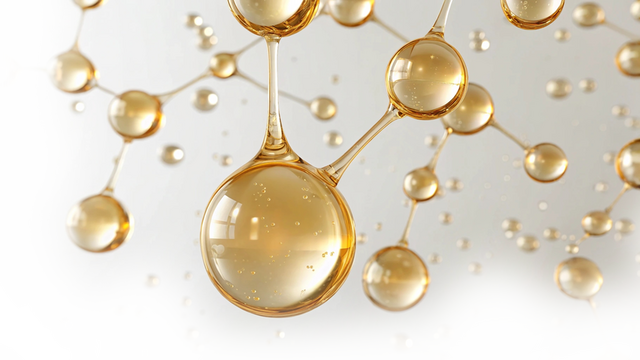
Panel discussion on...
Peptides
Commentary article
Peptides in Beauty: The Science, Innovation and Sustainable Future of Skin and Hair care
Peptides have become one of the most advanced and versatile active ingredients in the cosmetics industry, transforming skincare and hair care far beyond traditional anti-ageing applications. When I first joined the industry, skincare revolved around well-established ingredients like retinol and vitamin C, with peptides receiving limited attention. However, with advances in biotechnology, AI-driven peptide discovery and next-generation delivery systems, peptides have rapidly evolved from an underexplored concept to a cornerstone of high-performance actives. Today, peptides are at the forefront of innovation, offering targeted, multifunctional solutions that push the boundaries of beauty. But, as scientific advancement accelerate, the industry faces challenges: harnessing the full potential of peptides while balancing efficacy, safety and sustainability; a pursuit that is shaping the future of beauty.me.
The Rise of Peptides: The Expansion of Peptide Applications
The role of peptides in cosmetics has evolved significantly over the past few decades. Initially, peptides were primarily studied for their role in wound healing and medical applications. As research expanded, scientists discovered their ability to signal biological processes such as collagen production and cellular repair, leading to their integration into anti-ageing products.
The early 2000s marked a turning point with the introduction of synthetic peptides like Matrixyl (palmitoyl pentapeptide-4), which set new benchmarks for skin rejuvenation. Since then, biotechnology has unlocked the potential for highly specialised, stable peptides, offering more targeted and potent skincare solutions. Followed peptides were renowned for reducing wrinkles and firming skin. Now peptides have expanded across multiple cosmetic categories, addressing hydration, pigmentation, inflammation, stress-induced skin damage and even hair growth stimulation (1).
The growing demand for multifunctional skincare has further propelled peptide innovation. Unlike traditional single-target peptides, next-generation multifunctional peptides interact with multiple biological pathways. This holistic approach to skin health aligns with modern consumer preferences—shifting away from purely “anti-ageing” solutions toward enhancing overall skin resilience. As the concept of “well-ageing” gains traction, peptides are playing an essential role in promoting long-term skin vitality, reinforcing their position as one of the most versatile and impactful ingredients in modern skincare (2).
Breaking Boundaries: The Latest Innovations in Peptide Science
As someone who has followed beauty innovations closely, I’ve seen the peptide landscape undergoing a revolution, driven by cutting-edge biotechnology and a deeper understanding of the complex ageing process. Scientists are now designing bioengineered peptides with enhanced precision, targeting not just surface-level concerns but also cellular pathways that influence skin longevity. These advanced peptides can stimulate stem cell activity, regulate gene expression and support extracellular matrix regulation, which are key factors in slowing down skin ageing at a cellular level (3).
AI-assisted peptide discovery has further expanded possibilities by identifying multifunctional peptides that act on multiple skin targets simultaneously, allowing for formulations with fewer ingredients yet enhanced efficacy. Another emerging innovation is exosomic peptides, naturally contained within plant-derived exosomes. These peptides encapsulate bioactive molecules in a highly effective, biocompatible delivery system. At the forefront of these breakthroughs, biotechnology-driven peptide synthesis is revolutionising ingredient development by enabling the bioengineering of highly stable, nature-identical peptides (4). Through precision fermentation and enzymatic processes, scientists can now create peptides with enhanced purity, sustainability and targeted efficacy, eliminating the limitations of traditional extraction methods. This approach not only reduces environmental impact but also ensures consistent performance, positioning biotechnology as a driving force behind the next generation of skincare and hair care innovations.
Beyond skincare, peptide innovations are also transforming hair care, with biomimetic peptides strengthening follicles, reducing hair thinning and promoting scalp regeneration. Driven by the skinification trend, hair care is adopting skincare-inspired peptides that target scalp health for stronger, healthier hair. As research advances, the industry is moving toward sustainable, high-performance peptide solutions—merging biotechnology with nature to redefine the future of beauty and longevity science.
A key debate shaping this innovation is the distinction between natural and synthetic peptides. While synthetic peptides have long been valued for their stability and targeted action, advancements in biotechnology are now making natural peptides more effective than ever, closing the gap in potency while retaining their unique advantages. Derived from plant, marine, and bioengineered sources, these peptides offer enhanced biocompatibility, reduced risk of irritation, and multifunctional benefits that go beyond a single targeted effect (5). Innovations in formulation and delivery systems have also improved their stability and bioavailability, ensuring that natural peptides can now match or even surpass the efficacy of their synthetic counterparts (6). As sustainability becomes a priority in beauty science, the shift toward high-performance, naturally derived peptides is redefining the future of skincare—offering solutions that are not only effective but also environmentally responsible.
Overcoming Formulation Challenges: Enhancing Stability and Delivery for Maximum Peptide Efficacy
As exciting as peptides are, formulating with them presents distinct challenges, particularly in stability, bioavailability and ingredient compatibility. Peptides are highly sensitive to environmental conditions—factors such as temperature fluctuations, oxidation, enzymatic degradation and pH instability can rapidly reduce their effectiveness in cosmetic formulations (6). To overcome these challenges, advancements in delivery systems are playing a crucial role. Liposomal and nanoencapsulation technologies protect peptides from degradation while enhancing targeted skin penetration (7). Additionally, next-generation lipid-based carriers surpass traditional liposomes, offering greater emulsion stability and preserving peptide integrity over time (8).
Beyond delivery, peptide solubility and pH sensitivity require precise formulation strategies. Maintaining an optimal pH range (typically 4-6), integrating stabilisers like glycerin or glycols, and leveraging peptide complexes with enhanced hydrophobicity can significantly improve stability and absorption. A particularly exciting innovation is bioengineered self-stabilising peptides—designed to resist oxidation and hydrolysis, these peptides extend both efficacy and shelf life without requiring heavy stabilisers (9).
Moreover, peptide compatibility with other active ingredients requires meticulous balancing. Formulators must carefully assess interactions with acids, antioxidants and retinoids to maintain stability and efficacy. The rise of hybrid formulations, where peptides are strategically combined with synergistic ingredients, is gaining traction. This approach not only enhances skincare benefits, such as combining peptides with growth factors for skin regeneration or with ceramides for barrier repair, but also mitigates formulation constraints, ensuring all actives remain stable and effective.
With continuous advancements in peptide formulation science, brands can now optimise delivery, enhance absorption and improve stability, unlocking the full potential of peptides in modern skincare.
Sustainability in Peptide Manufacturing: Bridging Science and Ethics
Sustainability has become a cornerstone of beauty, and peptides are no exception. Traditional peptide synthesis often relies on resource-intensive processes with a significant environmental footprint. However, the industry is rapidly shifting toward greener alternatives such as bio-fermentation and enzymatic synthesis, which drastically reduce waste and energy consumption, while upcycled raw materials, such as oat waste, demonstrate how sustainability can be seamlessly integrated into peptide innovation. The potential of these methods is not only about their environmental benefits but also about their ability to produce high-quality, bioactive peptides with improved stability.
Yet, finding sustainable replacements for key ingredients is no easy feat. As company revise production process, they must balance efficacy, traceability and ethical sourcing—a challenge that continues to shape innovation. New peptides must be fully traceable, naturally derived and ethically produced, ensuring both performance and sustainability. However, the rewards of achieving this balance are significant. A well-executed shift toward sustainable peptide technology strengthens supply chain resilience, differentiates company from competitors and meets growing consumer demand for transparency and eco-conscious products.
Today’s consumers seek advanced yet natural skincare solutions. Unsurprisingly, brands that prioritise natural, cruelty-free and transparently sourced ingredients are thriving in this new beauty landscape. As the industry continues to evolve, I firmly believe sustainability will remain a driving force behind peptide innovation, shaping the next generation of ethical and effective skin and hair care.
The Future of Peptides: A Multifunctional, High-Performance Frontier
Peptides have transformed the cosmetics industry and their potential is still expanding. From my early days in the industry to now, I’ve seen peptides evolve from niche ingredients to essential components of high-performance beauty products. With continuous advancements in biotechnology, AI-driven molecular engineering, formulation techniques combined with sustainable production innovations, will unlock new applications across skincare and haircare products.
Looking ahead, the key to success lies in developing peptides that not only deliver superior performance but also align with evolving sustainability standards and consumer expectations. The fusion of scientific ingenuity and environmental responsibility will shape the future of peptide-powered personal care, ensuring they remain at the forefront of cosmetic innovation for years to come.
Panelists
References and notes
- Pintea A, et al. Peptides: Emerging Candidates for the Prevention and Treatment of Skin Senescence: A Review. Biomolecules. 2025 Jan 9;15(1):88.
- Ngoc LTN, Moon J-Y, Lee Y-C. Insights into Bioactive Peptides in Cosmetics. Cosmetics. 2023; 10(4):111.
- Flagler MJ, et al. Combinations of peptides synergistically activate the regenerative capacity of skin cells in vitro. Int J Cosmet Sci. 2021 Oct;43(5):518-529.
- Hou J, Wei W, Geng Z, Zhang Z, Yang H, Zhang X, Li L, Gao Q. Developing Plant Exosomes as an Advanced Delivery System for Cosmetic Peptide. ACS Appl Bio Mater. 2024 May 20;7(5):3050-3060.
- Apone F, Barbulova A, Colucci MG. Plant and Microalgae Derived Peptides Are Advantageously Employed as Bioactive Compounds in Cosmetics. Front Plant Sci. 2019 Jun 12;10:756.
- Badilli U, Inal O. Current Approaches in Cosmeceuticals: Peptides, Biotics and Marine Biopolymers. Polymers (Basel). 2025 Mar 18;17(6):798.
- Pandey AS, Bawiskar D, Wagh V. Nanocosmetics and Skin Health: A Comprehensive Review of Nanomaterials in Cosmetic Formulations. Cureus. 2024 Jan 22;16(1):e52754.
- Akombaetwa N, Ilangala AB, Thom L, Memvanga PB, Witika BA, Buya AB. Current Advances in Lipid Nanosystems Intended for Topical and Transdermal Drug Delivery Applications. Pharmaceutics. 2023 Feb 15;15(2):656.
- Nugrahadi PP, Hinrichs WLJ, Frijlink HW, Schöneich C, Avanti C. Designing Formulation Strategies for Enhanced Stability of Therapeutic Peptides in Aqueous Solutions: A Review. Pharmaceutics. 2023; 15(3):935.




































